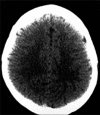Thunderclap headache: It is always sub-arachnoid hemorrhage. Is it? - A case report and Review
- PMID: 24778910
- PMCID: PMC3994686
- DOI: 10.4103/2152-7806.127756
Thunderclap headache: It is always sub-arachnoid hemorrhage. Is it? - A case report and Review
Abstract
Background: Spontaneous intracranial hypotension (SIH) is one of the relatively misdiagnosed pathophysiological entities by virtue of its presentation. SIH is a condition involving reduced intracranial pressure usually secondary to dural tear. There is recent increase in reporting of its varied presentation in literature. Critical care physicians and neurosurgeons are recognizing it in higher numbers than before. SIH is characterized by sudden onset of orthostatic headache and may be associated with neck stiffness, nausea, vomiting, tinnitus, deafness, and cognitive abnormalities. Since its imaging characteristics resemble classic subdural hematoma from other causes wrong diagnosis and intervention might have devastating outcome.
Case description: Here we discuss a case presented to us with severe headache of sudden onset without any associated problems. Patient was initially being treated as sinusitis and later diagnosed as bilateral subdural hematoma and surgical intervention was being considered. Thorough history taking and physical examination lead to strong suspicion of intracranial hypotension (IH) and patient showed dramatic improvement with epidural blood patch.
Conclusion: IH is a commonly misdiagnosed entity. A high index of suspicion is required for timely diagnosis, in order to minimize unwanted therapeutic interventions that can worsen the patient's condition and to help initiate early and simple interventions.
Keywords: Diagnosis; hypotension; intracranial; presentation; spontaneous.
Figures



Similar articles
-
Traumatic vs Spontaneous Cerebrospinal Fluid Hypotension Headache: Our experience in a series of 137 cases.Clin Neurol Neurosurg. 2020 Nov;198:106140. doi: 10.1016/j.clineuro.2020.106140. Epub 2020 Aug 7. Clin Neurol Neurosurg. 2020. PMID: 32791437
-
Brain herniation induced by drainage of subdural hematoma in spontaneous intracranial hypotension.Asian J Neurosurg. 2013 Apr;8(2):112-5. doi: 10.4103/1793-5482.116390. Asian J Neurosurg. 2013. PMID: 24049555 Free PMC article.
-
Misdiagnosis of Spontaneous Intracranial Hypotension Presenting as Acute Mental Deterioration Caused by Unilateral Acute Subdural Hematoma: Case Report.Korean J Neurotrauma. 2020 Oct 5;16(2):254-261. doi: 10.13004/kjnt.2020.16.e32. eCollection 2020 Oct. Korean J Neurotrauma. 2020. PMID: 33163434 Free PMC article.
-
Value of Targeted Epidural Blood Patch and Management of Subdural Hematoma in Spontaneous Intracranial Hypotension: Case Report and Review of the Literature.World Neurosurg. 2017 Jan;97:27-38. doi: 10.1016/j.wneu.2016.09.076. Epub 2016 Sep 28. World Neurosurg. 2017. PMID: 27693247 Review.
-
Headache in spontaneous intracranial hypotension: an overview with indications for differential diagnosis in the clinical practice.Neurol Sci. 2020 Dec;41(Suppl 2):423-427. doi: 10.1007/s10072-020-04642-9. Neurol Sci. 2020. PMID: 33034803 Review.
Cited by
-
Thunderclap headache as a first manifestation of acute disseminated encephalomyelitis: case report and literature review.BMC Neurol. 2024 Sep 4;24(1):315. doi: 10.1186/s12883-024-03803-z. BMC Neurol. 2024. PMID: 39232678 Free PMC article. Review.
References
-
- Bell WE, Joynt RJ, Sahs AL. Low spinal fluid pressure syndromes. Neurology. 1960;10:512–21. - PubMed
-
- Chen CC, Luo CL, Wang SJ, Chern CM, Fuh JL, Lin SH, et al. Colour doppler imaging for diagnosis of intracranial hypotension. Lancet. 1999;354:826–9. - PubMed
-
- Gordon N. Spontaneous intracranial hypotension. Dev Med Child Neurol. 2009;51:932–5. - PubMed
-
- Hedna VS, Kumar A, Miller B, Bidari S, Salardini A, Waters MF, et al. Intracranial hypotension masquerading as nonconvulsive status epilepticus. J Neurosurg. 2013 - PubMed
-
- Horikoshi T, Watanabe A, Uchida M, Kinouchi H. Effectiveness of an epidural blood patch for patients with intracranial hypotension syndrome and persistent spinal epidural fluid collection after treatment. J Neurosurg. 2010;113:940–6. - PubMed
Publication types
LinkOut - more resources
Full Text Sources
Other Literature Sources

